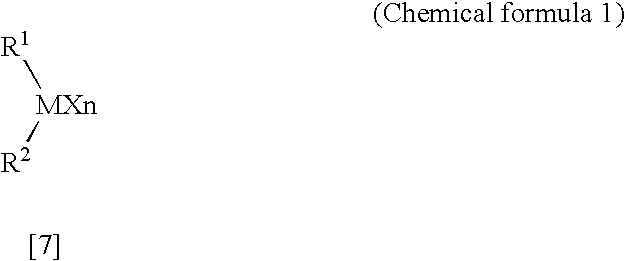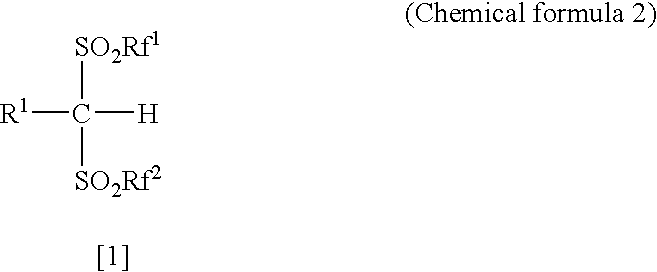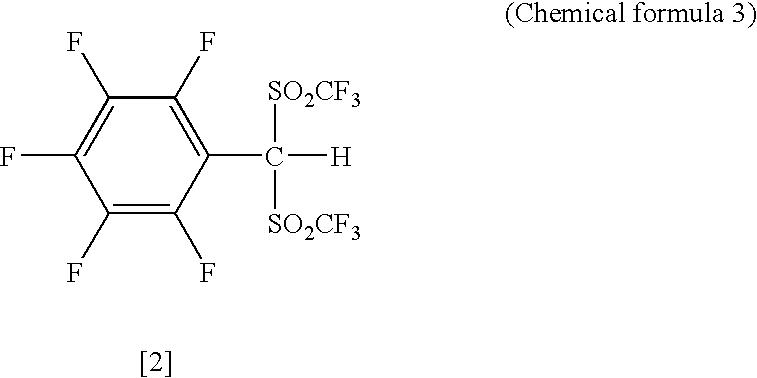Arylbis (perfluoroalkylsulfonyl)methane and metallic salt thereof, and methods for producing the same
a technology of perfluoroalkylsulfonyl and methane, which is applied in the preparation of carbonyl compounds, organic compounds/hydrides/coordination complexes, physical/chemical process catalysts, etc., can solve the problems of insufficient reactivity and selectivity of conventional lewis acid catalysts, inability to synthesize arylmethyl triflone at a high yield, and insufficient reactivity and selectivity
- Summary
- Abstract
- Description
- Claims
- Application Information
AI Technical Summary
Benefits of technology
Problems solved by technology
Method used
Image
Examples
example 1
Analysis and Material
The infrared radiation spectrum was determined by using a Shimadzu FTIR-9100. The 1H NMR spectrum was determined by using a Varian Gemini-300 (300 MHz) nuclear magnetic resonance apparatus. The chemical shift of 1H NMR was indicated by ppm wherein a solvent as an internal standard (tetramethylsilane at 0 ppm) was used. The division pattern was shown as singlet: s, doublet: d, triplet: t, quartet: q, multiplet: m and broad peak: br. The 13C NMR spectrum was determined by using a Varian Gemini-300 (125 MHz) nuclear magnetic resonance apparatus, and was indicated by ppm wherein a solvent as an internal standard (CDCl3at 77.0 ppm) was used. The 19F NMR spectrum was determined by using a Varian Gemini-300 (282 MHz) nuclear magnetic resonance apparatus, and was indicated by ppm wherein a solvent as an internal standard (CF3C6H5 at −64.0 ppm) was used. High-performance liquid chromatography (HPLC) analysis was conducted with a Shimadzu LC-10AD instrument and an SPD-M...
example 2
Synthesis of Arylmethyl Triflone
Each of the mixed solutions of aryl halomethyl (10 mmol), sodium trifluoromethane sulfinate (2.0 g: 13 mmol), propionitrile (30 mL) and tetrabutyl ammonium iodide (0.37 g: 1 mmol), shown in Table 1, were subjected to heating under reflux in an argon atmosphere for approximately 1 day. After the heating under reflux, the reaction solutions were cooled to room temperature, and were concentrated after removing the salt by filtration. The crude products obtained were purified by silica gel column chromatography (developing solvent: hexane-EtOAc) or recrystallization operation (hexane-toluene) to obtain arylmethyl triflone. The yield of each of the arylmethyl triflone is indicated in Table 1, and the physical property of each of the arylmethyl triflone is shown below. Table 1 showed that when sodium trifluoromethane sulfinate (TfNa) used as an electrophilic reactant as a triflyl source, and heating under reflux with aryl halomethane was conducted by usin...
example 3
Examination of the Method for Synthesizing Arylbis(triflyl)methane
The benzyl triflone obtained from Example 2 (0.5 mmol) was dissolved in diethylether (3 mL), this solution was cooled to −78° C., then added with 2.2 equivalent weight (1.1 mmol) of t-BuLi (0.34 mL, 1.6 M pentane solution), and was stirred for 0.5 hour. Next, after Tf2O (46 μL, 0.55 mmol) was added, the temperature of the reaction solution was raised to room temperature, and the solution was further stirred for 1 hour. Subsequently, water was added to stop the reaction, the solution was neutralized, and then washed with hexane. These aqueous phases were acidified with 4 M of hydrochloride, and were twice extracted with diethylether. The organic phase was dried, filtrated and concentrated with magnesium sulfate to obtain phenylbis(triflyl)methane [PhCHTf2] as a solid (79% yield). However, only a small amount of phenyltris(triflyl)methane [PhCTf3] was produced. Meanwhile, the same reaction as mentioned above, except f...
PUM
| Property | Measurement | Unit |
|---|---|---|
| Metallic bond | aaaaa | aaaaa |
| Efficiency | aaaaa | aaaaa |
| Equivalent weight | aaaaa | aaaaa |
Abstract
Description
Claims
Application Information
 Login to View More
Login to View More - R&D
- Intellectual Property
- Life Sciences
- Materials
- Tech Scout
- Unparalleled Data Quality
- Higher Quality Content
- 60% Fewer Hallucinations
Browse by: Latest US Patents, China's latest patents, Technical Efficacy Thesaurus, Application Domain, Technology Topic, Popular Technical Reports.
© 2025 PatSnap. All rights reserved.Legal|Privacy policy|Modern Slavery Act Transparency Statement|Sitemap|About US| Contact US: help@patsnap.com



